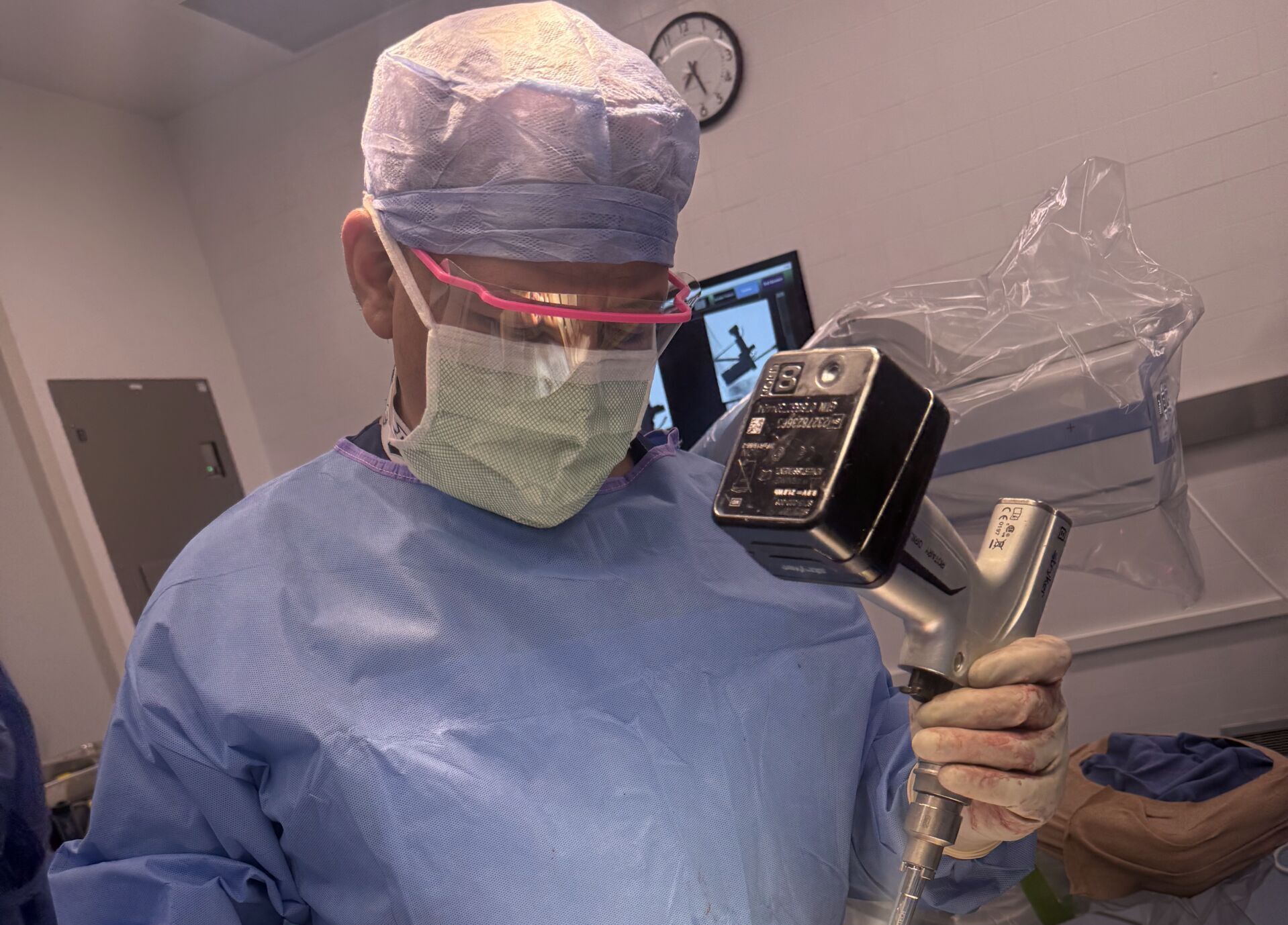SPINE PHYSIATRY: A conversation with Dr Tina Molumphy and Dr Manoj Mohan of Golden State Orthopedics & Spine
OVERVIEW
For centuries, people with disabilities have been treated by a variety of means, including motion, manipulation, and massage, to promote health, reduce pain, and improve physical function.
Physical medicine and rehabilitation (PM&R) officially became a medical specialty in the United States in 1947 and is now recognized as essential to improved healthcare.
Physiatry in general was developed to improve overall physical function and decrease pain. Spine physiatry focuses on patients with various spine issues. The spine physiatrist is an expert in the diagnosis and conservative management of spine disorders.
What motivated you to specialize in spine physiatry?

Dr. Molumphy: I grew up in an athletic family and was fascinated by anatomy. I wanted to help people improve their quality of life by improving function and decreasing pain.
Dr. Mohan: I personally have chronic low back pain and know first-hand how difficult it can be to manage. I have always had an academic interest in spine anatomy and enjoy doing procedures to help patients reduce their pain and improve their function.
Is a spine physiatrist an orthopedist?
Dr. Molumphy: No. We focus more on how to keep our patients from requiring surgery and know when it is time to refer to our excellent surgical colleagues.
Dr. Mohan: A spine physiatrist diagnoses and treats spine conditions to identify the primary structural pain generator. While they are experts in musculoskeletal medicine, they are not surgeons. They have the expertise to identify whether a condition should be treated conservatively with exercise/PT, or whether there is a target for an injection or surgery.
PATIENT ASSESSMENT
How do you typically assess patients with neck or back conditions?
Dr. Molumphy: I treat the patient, not just the MRI/X-ray. I listen to their history, do a thorough physical exam, and THEN look at their imaging to see how that “fits” with their complaint.
Dr. Mohan: We always start by taking a careful history to understand the onset, severity, and characteristics of the current symptoms. After synthesizing the relevant medical history, clinical exam, and imaging, we have a comprehensive discussion with the patient regarding various treatment options. These include exercise prescriptions, image guided injections/procedures, or surgery.
What causes the spine pain a physiatrist might treat?
Dr. Molumphy: Pinched nerves, spinal stenosis, peripheral nerve impingement (carpal tunnel, etc.), bursitis, osteoarthritis, joint pathology.
Dr. Mohan: As we get older, our spine accumulates wear and tear. The discs shrink in height, the joints develop some arthritis, and the nerves can be compressed. Sometimes these physiologic changes can cause pain. Through a careful exam and review of imaging, a spine physiatrist can often establish a diagnosis and help tailor an individualized treatment plan for patient.
What kind of problems and conditions does a spine physiatrist treat?
Dr. Molumphy: That is a very broad question as physiatrists are trained in head injury, spinal cord injury, amputations, sports medicine, in-patient rehabilitation, musculoskeletal pain, EMG/NCS (nerve testing), and spine intervention/pain management. Most physiatrists do not practice all of these subdivisions of physiatry.
a. Lumbar radicular pain: “sciatica” or a pinched nerve from the low back that causes pain and/or sensory symptoms down the leg
b. Cervical radiculopathy: Nerve pain/sensory symptoms radiating down the arm. (pinched nerve in the neck)
c. Lumbar spondylosis: general degenerative changes/arthritis of the low back
d. Cervical spondylosis: general degenerative changes/arthritis of the neck
e. Spondylolisthesis: A spinal disorder in which a bone (vertebra) slips forward onto the bone below it
f. SI joint pain: pain coming from the sacroiliac joint (where the pelvic bone meets the sacrum)
g. Myofascial pain: Pain emanating from the soft tissue structures of the spine, usually related to poor posture that causes muscular imbalance
What symptoms or conditions would lead you to recommend spine physiatry for a patient?
Dr. Molumphy: Less than 5% of people will require surgery. It is recommended that patients see a non-operative specialist prior to a surgeon UNLESS they have neurological deficit. Surgery is a last resort, and a physiatrist knows when they can and cannot help.
Dr. Mohan: Any patient with neck or back pain would benefit from a physiatrist evaluation.
DIAGNOSTIC APPROACH
What diagnostic tools do you commonly use for evaluating spine-related issues?
Dr. Molumphy: X-rays of the spine in multiple views and MRI without contrast.
Dr. Mohan: Imaging, including X-rays with multiple views, MRI, CT scans (not as common).
Physical exam: manual muscle testing and reflex exam to evaluate for limb weakness that could be a consequence of nerve damage from the cervical or lumbar spine.
How do you collaborate with other specialists, such as orthopedic surgeons or neurologists, in the diagnostic process?
Dr. Molumphy: I constantly am collaborating with my partners about patients. We share an office space that encourages us to discuss complicated cases.
Dr. Mohan: Good spine care requires a multidisciplinary approach with an open dialogue. Direct communication with our neurologic and surgical colleagues results in better patient care if the patient’s symptoms require an operation or further diagnostic evaluation. As spine physiatrists, we can guide the patient and coordinate care.
TREATMENT MODALITIES
What is an “interventional” procedure?
Dr. Molumphy: An interventional procedure is a procedure that is less invasive than surgery and alleviates pain or pathology.
Dr. Mohan: A diagnostic or therapeutic procedure often performed using imaging guidance such as fluoroscopy (X-ray) or ultrasound.
What are the primary treatment modalities you use for spine conditions?
Dr. Molumphy: Exercise, stretching, healthy lifestyle choices to maintain good body weight and strength, anti-inflammatories, and interventional procedures.
- Physical therapy, exercise/activity modification, lifestyle changes
- X-ray guided injections targeting specific pain generators in the spine
- Short term non-narcotic pain medications
- Referrals for alternative modalities such as chiropractor, acupuncture
Can you explain the role of physical therapy in spine physiatry, and how do you incorporate it into treatment plans?
Dr. Molumphy: People with spine pain often need to learn exercises to strengthen their core and hip musculature. As we age, we lose muscle mass. The role of PT is to give the patient exercises to maintain or build strength.
Dr. Mohan: Physical therapy is most often the first treatment modality recommended for any type of spine pain without concerning symptoms or clinical deficits. The goal of physical therapy is to identify painful or maladaptive movement patterns and strengthen adjacent muscle groups to minimize pain with functional movements.
Do you recommend and perform interventional procedures, such as epidural injections or nerve blocks?
Dr. Molumphy: Yes.
Dr. Mohan: If patients still experience significant pain despite conservative management and there is concordant structural pathology on MRI, there may be a role for interventional procedures. Spine physiatrists perform X-ray guided epidural steroid injections, nerve blocks, and joint injections in the appropriate clinical scenario.
Are there any side effects from spine physiatry treatments?
Dr. Molumphy: Of course there are.
Dr. Mohan: As with any interventional procedure, there are associated risks including bleeding, infection, worsening pain, weakness/paralysis. The risk of a significant complication is quite low (significantly less than 1%) when done using proper sterile and procedural technique.
Do spine physiatrists do surgery?
Dr. Molumphy: Most physiatrists do not do surgery.
Dr. Mohan: Short answer: most often no. Most interventional procedures are done using either local anesthetic or conscious sedation without any surgical incision or hardware placement.
Nuanced answer: it depends. Based on their training, certain spine physiatrists feel comfortable performing minimally invasive surgeries under general anesthesia.
What’s the difference between physiatry and physical therapy?
Dr. Molumphy: Physiatrists are medical doctors (4 years of medical school and 4 years of Residency and Board Certified). Physical therapists, while claiming they are a “doctor” of PT, have NOT attended medical school.
Dr. Mohan: A physiatrist is a physician (medical school+residency/fellowship training+Board Certification), a physical therapist is not. A physiatrist and physical therapist work closely together to tailor a rehabilitation plan specific to a patient’s diagnosis and baseline level of function.
PATIENT EDUCATION
How do you educate patients about their spine conditions and treatment options?
Dr. Molumphy: I have models in the clinic that show the aging problems the spine encounters. I show the patient what normal is and then review their X-rays and MRI with them.
- Anatomy: We discuss pertinent anatomy of the spine using models and possible pain generators based on the patient’s symptoms, imaging, and clinical exam.
- Reassurance: We discuss different treatment options and how the presence of pain often does not indicate structural compromise that requires immediate surgery.
- Motivation: Rehabilitation is not a passive process. It is important to emphasize that consistent strengthening and stabilization should be the tenets of any rehab plan.
- Risks: A risk/benefit discussion is essential when considering a spine intervention. The patient must decide whether the level of risk is acceptable and if the severity of the pain warrants an intervention.
What lifestyle modifications do you commonly recommend to your patients?
Dr. Molumphy: Healthy lifestyles are essential to maintain good health in all areas of medicine. I recommend regular cardiovascular training, stretching and a VERY healthy diet to maintain a normal BMI.
Dr. Mohan: A healthy diet, frequent exercise (at least 30 minutes a day), proper stress management, and adequate sleep go a long way with managing chronic pain. Exercise releases endorphins which are endogenous painkillers.
COLLABORATION WITH OTHER SPECIALISTS
How do you coordinate care with other healthcare professionals, including surgeons or pain management specialists?
Dr. Molumphy/Dr. Mohan: In our clinic we refer patients to the surgeons when appropriate. We are all on the same medical record system. For complicated cases we will seek out the surgeon to discuss the complexities.
In what situations do you typically refer patients to other specialists?
Dr. Molumphy/Dr. Mohan: When the scope of the patient’s pathology is out of our expertise.
PROGNOSIS AND EXPECTATIONS
What can patients expect in terms of recovery and improvement with spine physiatry?
Dr. Molumphy/Dr. Mohan: Patients can expect that if they choose to participate in their rehab on a regular basis that they will improve their function. There are limits to the magnitude of relief and how long steroid injections can help with the pain.
How do you manage expectations regarding the timeline of improvement and the need for ongoing care?
Dr. Molumphy/Dr. Mohan: We try to explain the natural aging process of the spine to the patient and discuss how much improvement they can expect with their pathology.
EMERGING TRENDS AND TECHNOLOGIES
Are there any emerging trends or technologies in spine physiatry that you find particularly promising or interesting?
Dr. Molumphy/Dr. Mohan: Yes. Intracept is a relatively new procedure that is showing promise for lower back pain caused by injury to the vertebral endplates. There is a growing body of evidence for peripheral nerve and spinal cord stimulation treatments as well.
How do you stay updated on the latest advancements in your field?
Dr. Molumphy: I am an active member and instructor for the International Pain & Spine Intervention Society (IPSIS). I attend annual meetings and courses regularly to sharpen my skill set.
Dr. Mohan: I am an active member with IPSIS. I attend annual meetings and have presented and won awards for best research at national conferences.
PATIENT CENTERED CARE
How do you approach patient-centered care in your practice?
Dr. Molumphy/Dr. Mohan: Each patient is an INDIVIDUAL first! We treat the whole person, not just the disease.
What steps do you take to ensure that patients actively participate in their treatment plans?
Dr. Molumphy/Dr. Mohan: We explain that the treatment starts with the patient doing their exercises, then if that doesn’t work consideration for an intervention will be given. Insurances now also require they have done physical therapy and are regularly doing a home exercise program.
PROFESSIONAL DEVELOPMENT
Can you discuss any additional certifications, training, or continuing education you have pursued in the field of spine physiatry?
Dr. Molumphy: In 2023 I became an instructor for the International Spine Intervention Society. It was a vigorous vetting process that took a full year to complete. I now teach physicians the procedures that I do for the spine.
Dr. Mohan: I completed my residency in physical medicine and rehabilitation and a subsequent fellowship in performing interventional spine procedures, both at Stanford. I am board certified in physical medicine and rehab and certified as an operator in the use of fluoroscopy for advanced interventional spine procedures.
How do you stay current with the latest research and guidelines in your specialty?
Dr. Molumphy/Dr. Mohan: We read the monthly journals and attend annual meetings.
INSURANCE AND BILLING
Are spine physiatry treatments covered by insurance?
Dr. Molumphy/Dr. Mohan: Yes, with some exceptions. [such as Orthobiologics (stem cells, Platelet Rich Plasma etc).]
How do you work with insurance providers to ensure that patients have access to the necessary treatments?
Dr. Molumphy/Dr. Mohan: In order to get some procedures authorized, we do peer to peer discussions with the insurances to argue denials and advocate for patients.
Are there any financial considerations or assistance programs available for patients undergoing spine physiatry?
Dr. Molumphy/Dr. Mohan: Not to our knowledge.
Where can I get spine physiatry treatments locally?
Dr. Molumphy/Dr. Mohan: Golden State Orthopedics & Spine!
Additional source:
Physical Medicine and Rehabilitation: From the Birth of a Specialty to Its Recognition
Monitoring Editor: Alexander Muacevic and John R Adler



